Description

Disclaimer: Copyright infringement not intended.
Context
- NASA’s OSIRIS-REx (Origins, Spectral Interpretation, Resource Identification and Security–Regolith Explorer) spacecraft briefly touched the Bennu asteroid’s surface and collected a sample of rock and dust from the asteroid in 2020.
- Today, it sped past Earth and jettisoned its sample capsule containing material from the asteroid
Details
- NASA's OSIRIS-REx mission was a historic spacecraft mission designed to study and collect a sample from an asteroid called Bennu.
- The mission was launched in September 2016 and achieved numerous milestones before successfully returning a sample of Bennu's surface material to Earth in September 2023.
Mission Objectives
The primary objectives of the OSIRIS-REx mission were to:
- Survey and Characterize Bennu: The spacecraft was tasked with extensively studying Bennu, including its composition, shape, topography, and rotation. This information was crucial for selecting a safe and scientifically valuable sample site.
- Collect a Sample: OSIRIS-REx was designed to collect at least 60 grams (2.1 ounces) of surface material from Bennu. This sample could provide insights into the early solar system's composition and the origins of life on Earth.
- Return the Sample: After collecting the sample, OSIRIS-REx was to safely transport it back to Earth, allowing scientists to analyze the pristine asteroid material in laboratories on Earth.
.jpg)
Spacecraft and Instruments
The OSIRIS-REx spacecraft was equipped with various scientific instruments and systems to achieve its objectives:
- OCAMS (OSIRIS-REx Camera Suite): This suite of cameras included MapCam, PolyCam, and SamCam, which were used to map Bennu's surface, navigate the spacecraft, and document the sample collection process.
- OTES (OSIRIS-REx Thermal Emission Spectrometer): OTES measured the temperature of Bennu's surface to help determine its composition.
- OVIRS (OSIRIS-REx Visible and Infrared Spectrometer): OVIRS analyzed the spectral properties of Bennu's surface to identify minerals and organic compounds.
- OLA (OSIRIS-REx Laser Altimeter): OLA provided topographical data to create detailed 3D maps of Bennu's surface.
- TAGSAM (Touch-And-Go Sample Acquisition Mechanism): This device was responsible for collecting the sample. It used a nitrogen gas burst to stir up surface material, which was then captured in a sample collector.
Key Mission Events
- Launch: OSIRIS-REx was launched aboard an Atlas V rocket from Cape Canaveral Air Force Station on September 8, 2016.
- Asteroid Arrival and Survey: The spacecraft arrived at Bennu in December 2018, conducted extensive surveys, and identified potential sample collection sites.
- Sample Collection: On October 20, 2020, OSIRIS-REx successfully touched down on Bennu's surface, collected a sample, and then safely stowed it in the Sample Return Capsule (SRC).
- Departure from Bennu: After spending more than two years at Bennu, OSIRIS-REx departed from the asteroid in May 2021.
- Sample Return to Earth: The spacecraft traveled back to Earth and released the SRC, which re-entered Earth's atmosphere and landed in the Utah desert on September 24, 2023.
Scientific Significance
The OSIRIS-REx mission has significant scientific implications:
- Understanding the Early Solar System: The collected sample is expected to contain pristine material from the early solar system, shedding light on the conditions and processes that led to the formation of planets and life.
- Asteroid Impact Hazard Assessment: Studying Bennu's properties and trajectory helped improve our understanding of asteroid dynamics and potential impact hazards.
- Resource Utilization: Bennu contains valuable resources, such as water and organic molecules, which could be of interest for future space exploration and resource utilization efforts.
- Origins of Life: The mission's findings could provide insights into the delivery of organic molecules and water to Earth, potentially contributing to the understanding of the origins of life.
Bennu: The Asteroid of Interest
- Physical Characteristics:
- Size and Shape: Bennu is a relatively small asteroid with a diameter of approximately 492 meters (about 1,614 feet). It is roughly spherical in shape.
- Rotation: Bennu has a slow rotation period of about 4.3 hours, which is relatively rapid for an object of its size.
- Orbit and Origin:
- Orbit: Bennu follows an elliptical orbit around the Sun, which brings it close to Earth's orbit. It is classified as a near-Earth asteroid (NEA).
- Origin: Bennu is believed to be a primitive asteroid, dating back to the early solar system, about 4.5 billion years ago. It is considered a carbonaceous asteroid, suggesting that it contains carbon-rich and potentially organic materials.
- Scientific Significance:
- Time Capsule: Bennu is like a time capsule, preserving materials from the early solar system. Studying it can provide valuable insights into the conditions, composition, and processes that prevailed during the formation of our solar system.
- Water and Organic Compounds: It is thought that Bennu contains water-bearing minerals and organic compounds, making it a potential source of resources for future space exploration and possibly shedding light on the origins of life on Earth.

Conclusion
The mission's collected sample is expected to be studied for decades, contributing to our understanding of the solar system's origins and potentially offering new clues about the development of life on Earth.
|
PRACTICE QUESTION
Q. Consider the following statements regarding NASA's OSIRIS-REx mission:
1. OSIRIS-REx successfully collected at least 60 grams of surface material from the asteroid Bennu.
2. One of the instruments on OSIRIS-REx, OVIRS, analyzed the temperature of Bennu's surface.
3. The mission's Sample Return Capsule (SRC) landed in the Nevada desert upon its return to Earth.
Which of the following options is correct?
A) Only Statement 1 is true.
B) Statements 1 and 2 are true.
C) Statements 2 and 3 are true.
D) All three statements are true.
Answer: B)
|











